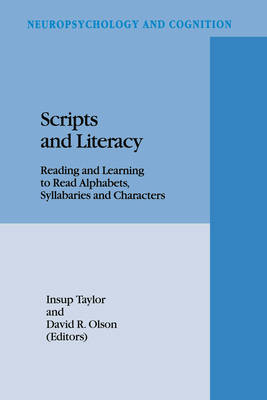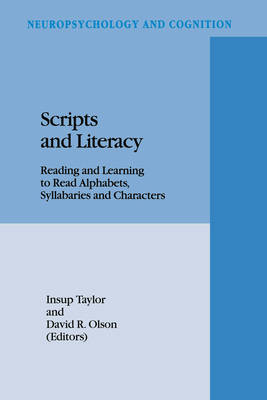
- Retrait gratuit dans votre magasin Club
- 7.000.000 titres dans notre catalogue
- Payer en toute sécurité
- Toujours un magasin près de chez vous
- Retrait gratuit dans votre magasin Club
- 7.000.000 titres dans notre catalogue
- Payer en toute sécurité
- Toujours un magasin près de chez vous
Scripts and Literacy:
Reading and Learning to Read Alphabets, Syllabaries and Characters
Insup Taylor, David R Olson
151,45 €
+ 302 points
Description
Preface. 1. An introduction to reading the world's scripts; I. Taylor, D.R. Olson. Part I: Optional and Optimal Scripts. 2. Scripts and writing systems: a historical perspective; A. Gaur. 3. Optimal orthographies; H. Rogers. 4. Logographic and semasiographic writing systems: a critique of Sampson's classification; J.M. Unger, J. DeFrancis. 5. The Cree syllabary and the writing system riddle: a paradigm in crisis; S. McCarthy. 6. Developing orthographies: the Athapaskan languages of the Northwest Territories, Canada; K.D. Rice. 7. Orthography and reading in Kannada -- a Dravidian language; P. Prakash, R. Malatesha Joshi. Part II: Reading Processes for Different Scripts. 8. How English is read: grapheme-phoneme regularity and orthographic structure in word recognition; R.L. Venezky. 9. Getting at the sound and meaning of logographic and alphabetic scripts; R. Hoosain. 10. Script factors that affect literacy: alphabetic vs. logographic languages; In-Mao Liu. 11. Orthographic and psycholinguistic considerations in developing literacy in Chinese; Che Kan Leong. 12. Differential processing of content words and function words: Chinese characters vs. phonetic scripts; I. Taylor, Kwonsaeng Park. Part III: Early Stage of Learning to Read. 13. Teaching Japanese toddlers to read Kanji and Kana; M.T. Steinberg. 14. Asymmetries between reading and writing for Japanese children; J. Yamada. 15. Reading disabilities in Japan: implications from the study of hemisphere functioning; T. Hatta, T. Hirose. 16. Writing systems and acquisition of reading in American, Chinese, and Japanese first-graders; Shin-Ying Lee, D.H. Uttal, Chuansheng Chen. 17. Brahmi scripts, orthographic units and reading acquisition; P.G. Patel. 18. Orthographic and cognitive processing in learning to read English and Hebrew; E. Geva. Part IV: Cognitive and Metalinguistic Implications of Learning to Read. 19. Script directionality affects nonlinguistic performance: evidence from Hindi and Urdu; J. Vaid. 20. Cognitive consequences of L1 and L2 orthographies; K. Koda. 21. Lexical representation of script variation: evidence from Korean biscriptals; Kwonsaeng Park, J. Vaid. 22. Syllabic literacy and cognitive performance among the Cree and Ojibwe people of Northern Canada; J.W. Berry, J.A. Bennett. 23. Orthography, vision, and phonemic awareness; R.J. Scholes. Index.
Spécifications
Parties prenantes
- Auteur(s) :
- Editeur:
Contenu
- Nombre de pages :
- 400
- Langue:
- Anglais
- Collection :
- Tome:
- n° 7
Caractéristiques
- EAN:
- 9780792329121
- Date de parution :
- 31-01-95
- Format:
- Livre relié
- Format numérique:
- Genaaid
- Dimensions :
- 156 mm x 234 mm
- Poids :
- 734 g







